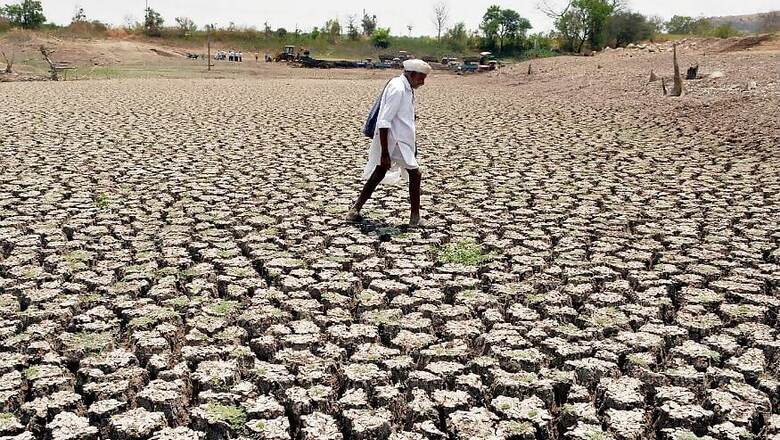
views
Khandoba and Vithoba, deities of the Deccan Plateau, are believed to hold the reins of the monsoon cycle. The word monsoon, derived from the Arabic mawsin for season, refers to the seasonal winds that carry rains to the Indian subcontinent.
The onset and retreat of the monsoon as part of the hydrological cycle drives several interconnected cyclical activities such as agriculture, grazing and seasonal migration. Given that agriculture was and continues to be the primary occupation for most of the population, it is no surprise that most of the festivals in Indian subcontinent revolve around it.
The Deccan Plateau, characterised by molten lava and consisting of large scrub plains and grasslands, is home to pastoral communities. The soil layer is thin for the most part, barring the river basins of Godavari, Krishna and Kaveri.
The annual average rainfall on the plateau rarely exceeds 600 mm. Given these factors, the major crops of this region are millets – jawar and bajra – besides pulses and oilseeds.
The plateau is surrounded by the Western and Eastern Ghats in addition to the Satpura and Balaghat mountain ranges. Its boundaries are dotted by temples of Khandoba across the five states of Madhya Pradesh, Maharashtra, Karnataka, Andhra Pradesh, and Telangana.
According to German anthropologist Gunther Sontheimer, the cult of Khandoba dates back to well before the 12th century. Vithoba was also the God of pastoralists but gradually agriculturists and more particularly, the Vaishnavas became his principal devotees.
Sleep of the Gods
Chaturma – the four-month monsoon period – is reserved for penance and fasting as Hindus believe that Lord Vishnu and other gods and goddesses rest during these four months.
Chaturmas commences on the 11th day of Ashad, the fourth month of Hindu lunar calendar. By this time, with the sowing of Kharif crops completed, the Vaishnavas set out for pilgrimage to Pandharpur, the principal shrine of Vithoba that attracts millions of devotees from the four states of Maharashtra, Karnataka, Telangana and Andhra Pradesh.
After the four-month-long nap, Lord Vishnu is believed to wake up on the eleventh day of Kartika, the eighth month of the Hindu lunar calendar. This too is a day of pilgrimage for the Vaishnavas. By this time, the Kharif crop has been harvested, the villagers have celebrated Diwali and the Rabi sowing is about to begin.
These annual pilgrimages are thanksgiving ceremonies for good rains and harvest. They have inspired generations of saints in Maharashtra. These upstart preachers, who rapidly gained popularity with the masses, came up with new religious doctrines in defiance of Brahmanism. They are credited with not merely contributing to modern poetry, but also with bringing about revolutionary change in literature and the very development of the Marathi language.
With the onset of the monsoon, pastoral tribes such as Dhangars, Kurumas and Gollas reach their village. They engage in agriculture for four months. After the harvest of the Kharif crops, they set out with their herds of sheep and goats or cattle in search of grasslands in the mountain ranges.
They are welcomed by farmers to replenish the soil depleted of nutrients with the manure of sheep and goats. Thus, going by the pattern of their seasonal migration, pastoral communities engage in agriculture only for the Kharif season, while other farmers reap both harvests of Kharif as well as Rabi.
Wake-up Call
Today, the Deccan Plateau has the dubious distinction of being the hotspot of farmers’ suicides. Maharashtra has the largest number of irrigation projects (1,845) in the country but the state has miserably failed to address the drinking water issue during the drought years.
With the burgeoning population and rampant drilling of bore-wells, the water table is rapidly plummeting. Further, the Deccan Trap is made of non-porous basalt rock, which in itself is not conducive to the percolation of rain water. With land holdings shrinking, sustainable agriculture is fast becoming history.
The Maratha-Kunbi community is in bad shape, barring those who are engaged in sugarcane and horticulture in the Krishna river basin.
The situation is even worse for the herders. Demand-driven agriculture has devastated the ecosystem of the Deccan Plateau. Grasslands are shrinking, thanks to multiple policies that deny grazing rights to shepherds. New breeds of sheep have been introduced, but these are not as sturdy as native breeds that can withstand the heat of the plateau and migration.
Seeds of sustainability
In the 90s, the Maharashtra government accepted the recommendations of the Mandal Commission Report. Malis (a gardening community) were included amongst Other Backward Castes (OBCs) – this opened a veritable Pandora’s Box with the Maratha-Kunbis and Dhangars too clamouring for the special quota so as not to encroach upon the reservations of other communities.
In 2014, the Congress-Nationalist Congress Party alliance government in Maharashtra announced a special quota for the powerful Maratha-Kunbis that acted as a trigger for the Dhangars to switch their loyalty from the Congress to the Bharatiya Janata Party (BJP) that subsequently came to power, in the same year.
In India, reservations provide a portal for designated backward communities to get government jobs. Such jobs are seen as paving the road to prosperity for those left behind so that they get integrated with the centralized economic system of production, distribution and consumption.
The real challenge before us is how we synchronize the centralized system of production with the decentralized and traditional systems that depend on various interlinked cycles driven by monsoon winds.
It is imperative that we create a system that will help shepherds and other nomadic tribes to leverage their traditional wisdom, knowledge, skills and potential.
Modern science and technology should be used to sow seeds of sustainability that will revive the symbiotic relationship between agriculture, grasslands and forests. Only then, perhaps, will Khandoba and Vithoba smile on the suffering masses.
(Sunil Tambe is former Editor of Reuters Market Light)



















Comments
0 comment